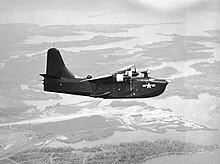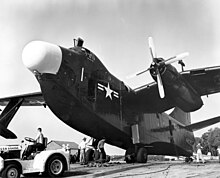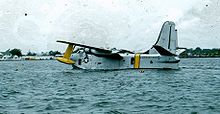Martin P5M
| Martin P5M / P-5 Marlin | |
|---|---|
 Martin P5M-2G of the US Coast Guard |
|
| Type: | Maritime patrol aircraft |
| Design country: | |
| Manufacturer: | |
| First flight: |
May 30, 1948 |
| Commissioning: |
Late 1951 |
| Production time: |
1948 to December 1960 |
| Number of pieces: |
285 or 267 |

The Martin P5M Marlin was the last flying boat in service with the US Navy and US armed forces in general.

history
The P5M Marlin was built by the Glenn L. Martin Company in Middle River , Maryland . She was the successor to the Martin PBM Mariner . The prototype XP5M Marlin was based on the Mariner with a new hull design and a new conventional tail section.
The Marlin had gull wings again , so that the engines could be positioned high enough to prevent splash water from entering. She was powered by two Wright R-3350 star engines. The hull shape was inspired by the Japanese Kawanishi H8K from WWII . The fuselage rose slightly towards the end and gave the aircraft a better glide behavior at takeoff.
The prototype had two 20 mm cannons in the nose and two in the stern, as well as a turret on the rear fuselage with two 12.7 mm machine guns. The cockpit was taken over by the Mariner.
The first flight took place on May 30, 1948. In December 1949 Martin received the order to build four P5M-1 series machines, which differed considerably from the prototype XP5M-1. Another order from the US Navy for 163 machines followed in 1950, all of which were delivered by April 1954. Of these, 156 P5M-1 went to the Navy itself and seven P5M-1G were destined for the US Coast Guard.
The changes to the P5M-1 compared to the prototype were a raised cockpit for improved visibility, the reinstallation of the nosepiece with a large radome for the search radar AN / APS-44, the removal of the fuselage turret and new aerodynamic wings. The engine nacelles have been lengthened to provide space for weapon bays in the rear.
On November 25, 1959, a US Navy P5M ditched in Puget Sound near Whidbey Island in Washington state. A nuclear-tipped On board was water balloon type MK90 "Betty". The weapon has not yet been found.
The P5M-1 was followed by 117 P5M-2 machines. These had a T-tail, a Magnetic Anomaly Detector AN / ASQ-8 MAD in the rear, no rear armament, better crew rooms and a better floor shape to avoid splashing water.
Gun loading variants
- 4 × 980 kg torpedoes.
- 4 × 900 kg mines or bombs
- 8 × 450 kg mines.
- 16 × 230 kg bombs.
- 16 × 150 kg depth charges
- 1 × Mark 90 "Betty" (nuclear equipped depth bomb )
Versions
- P5M-1 (from September 1962 P-5A)
- first production series for the US Navy. 160 pieces built
- P5M-1S (SP-5A)
- revised P5M-1 with new electronics and anti-submarine equipment
- P5M-2 (P-5B)
- second production series for US Navy. 115 pieces built
- P5M-1G
- Transfer of seven machines to the US Coast Guard
- P5M-1T (TP-5A)
- former P5M-1G continued to be used for training purposes by the US Navy
- P5M-2G
- Transfer of four machines to the US Coast Guard
- P5M-2S (SP-5B)
- Most of the P5M-2's were converted with better flight controls and anti-submarine equipment
- SP-5
- SIGINT / ELINT version used in the Vietnam War
US Coast Guard
Seven P5M-1Gs and four P5M-2Gs were converted for the US Coast Guard for sea rescue. However, the planes proved difficult to maintain and were therefore returned to the US Navy . She then used them as an unarmed trainer.
French Navy
In 1959 the French Navy received ex-US Navy Marlins to replace their old Short Sunderlands . These were used for sea patrols in Dakar in Senegal . They were returned five years later.
Technical specifications
| Parameter | Data from the P5M-2 Marlin |
|---|---|
| Length: | 30.7 m |
| Wingspan: | 36.0 m |
| Wing area: | 130.1 m² |
| Height: | 10.0 m |
| Drive: | 2 × radial engines Wright R-3350-32WA with 3,450 HP (2,570 kW) each |
| Top speed: | 404 km / h |
| Range: | 3,300 km |
| Crew: | eight men |
| Service ceiling: | 7,300 m |
| Empty weight: | 22,900 kg |
| All-up weight: | 38,600 kg |
| Armament: | Bomb loading s. text |
Web links
Individual evidence
- ^ ER Johnson: American Flying Boats and Amphibious Aircraft , McFarland and Co., 2009, p. 261
- ^ ER Johnson: American Flying Boats and Amphibious Aircraft , McFarland and Co., 2009, p. 259




